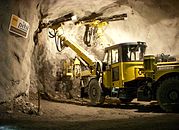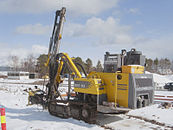Atlas Copco
This article has multiple issues. Please help improve it or discuss these issues on the talk page. (Learn how and when to remove these messages)
|
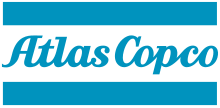 | |
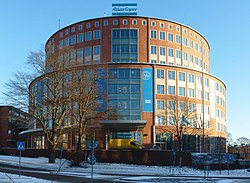 Atlas Copco main office in Nacka (2015) | |
| Company type | Aktiebolag |
|---|---|
| Nasdaq Stockholm: ATCO A, ATCO B | |
| ISIN | |
| Industry | Industrial equipment |
| Founded | 1873 |
| Founder | Edvard Fränckel |
| Headquarters | Nacka (Stockholm County), Sweden |
Key people | Hans Stråberg (Chairman), Vagner Rego (President and CEO) |
| Products | Compressors, vacuum technique, generators, construction, industrial tools and assembly systems |
| Revenue | |
| Total assets | |
| Total equity | |
Number of employees | ≈53,000 (2023) |
| Subsidiaries | Atlas Copco, Chicago Pneumatic, Desoutter, Edwards, Henrob, BeaconMedaes, Quincy Compressor, SCA, Nano-Purification Solutions Leybold |
| Website | www |
| Footnotes / references [4][5][6] | |
Atlas Copco (Copco from Compagnie Pneumatique Commerciale) is a Swedish multinational industrial company that was founded in 1873.[7] It manufactures industrial tools and equipment.
The Atlas Copco Group is a global industrial group of companies headquartered in Nacka, Sweden. In 2019, global revenues totaled kr 104 billion, and by the end of that year, the company employed about 38,774 people. The firm's shares are listed on the Nasdaq Stockholm exchange and both 'A' and 'B' classes form part of the benchmark OMXS30 index.
Atlas Copco companies develop, manufacture, service, and rent industrial tools, air compressors (of which it is the world's leading producer),[8] construction and assembly systems. The Group operates in four areas: Compressor Technology, Vacuum Technology, Power Technology and Industrial Technology.[9]
History
[edit]Early development
[edit]AB Atlas, as it was previously named, was founded by Edvard Fränckel, who was a Swedish industrialist, politician and senior official at the Swedish State Railways. The company was established along with Andre O. Wallenberg, Johan W. Arnberg, Carl G. Cervin and Fredrik Didro.
In its inauguration phase, Atlas dealt with the manufacturing, purchasing and selling of material for railway construction and operations. After the recession in the 1880s, Atlas diversified its products and branched off into locomotives, central heating and tool machinery. In 1899, Atlas began developing their first air compressors and established itself as a compressor manufacturer. As older production branches started phasing out, Atlas teamed up with Diesel Motors in 1917, and the new company, Atlas Diesel, emerged with two primary divisions: diesel engines and compressor air products.[10]
War-time development
[edit]The Atlas Diesel merger experienced significant growth during the First World War and towards the end of the war, the export was 40–50 % of production. The depression years caused significant losses for the company, which led to several financial reconstructions in the 1920s and 1930s.
During the Second World War, manufacturing capabilities were developed. The "Swedish method" influenced the firm's pneumatic program, consisting of lightweight rock drills and drill bits with carbide tips. In 1948, the company terminated its diesel manufacturing and the name "Atlas Diesel" was no longer pertinent. The name Atlas Copco became official in 1955 and was inspired by the Belgian subsidiary Compagnie Pneumatique Commerciale (Trading Pneumatic Company).
Post-war international expansion
[edit]The acquisition of the Belgian compressor company Arpic Engineering in 1956, was the firm's first major international acquisition. Eventually, Arpic's plants carried out the majority of Atlas Copco's compressor production. In 1960, the company purchased Craelius. In the 1970s, a number of strategic acquisitions were made, including the French compressor manufacturer Mauguière. In order to strengthen their position in the United States, several strategic acquisitions were made in the airpower business, including the key purchase of Worthington Compressors.[11]
They purchased Chicago Pneumatic Tools in 1987. In 1992, AEG Elektrowerkzeuge was purchased, and in 1995, Milwaukee Electric Tool was acquired. In 2004, Milwaukee Electric Tool was sold to a Hong Kong-based manufacturer, Techtronic Industries.[12] In 1997, Atlas Copco purchased Prime Service Corporation, which was the largest machine leasing company in the United States. The North American Rental Service Corporation was purchased in 1999.[11]
Business areas
[edit]-
Tunnel drilling machine "Rocket Boomer E2C", model 2009. The Rock Drilling is a part of Epiroc.
-
ROC D3
-
Atlas Copco equipment in the construction of West Link. The construction equipment is no longer part of AC.
Since 2017, Atlas Copco has had four main business areas: Compressor Technique, Vacuum Technique, Industrial Technique and Power Technique.[13]
Compressor Technique
[edit]Atlas Copco's Compressor Technique area creates products such as industrial compressors, oil and gas treatment equipment, air management systems, and gas and process compressor and expanders. The products are mainly used in the manufacturing, oil, gas and process industries.[14]
Vacuum Technique
[edit]Atlas Copco's Vacuum Technique business area provides vacuum products, exhaust management systems, valves and related products mainly under the Edwards, Leybold and Atlas Copco brands. The main markets served are semiconductors, chemical processing industries, food packaging and paper handling. Principal product development and manufacturing units are located in the United Kingdom, Czech Republic, Germany, South Korea, the United States, China and Japan.
Industrial Technique
[edit]Atlas Copco's products in Industrial Technique are mainly developed for the automotive and aerospace industries, but are also used in industrial manufacturing, maintenance and vehicle service. Products manufactured include assembly systems, industrial power tools, quality assurance products and various types of software.[15]
Power Technique
[edit]This area produces portable compressors, lighting towers, pumps, generators, paving equipment, compaction equipment, demolition tools and construction tools for infrastructure projects. These include civil works, road construction, gas and oil, and drilling construction projects.[16]
Operations
[edit]Atlas Copco manufactures critical equipment components in-house and cooperates with business partners for non-critical components. Approximately 75% of the production cost of equipment represents purchased components and around 25% are internally manufactured core components, assembly costs and overhead. Equipment represents less than 64% of revenues and the manufacturing of equipment is primarily based on customer orders. Only some standard, high-volume equipment is manufactured based on projected demand.[17]
Atlas Copco has customer centres in about 71 countries and sales in about 180 countries. Sales and service are primarily direct but also channeled through alternative sales mechanisms, e.g. distributors. Sales of equipment are performed by engineers and service and maintenance are performed by technicians. Service is the responsibility of divisions in each business area. The responsibility includes the development of service products, sales and marketing, technical support, service delivery and follow-up. About 36% of revenues are generated from services (spare parts, maintenance, repairs, consumables, accessories and rental).[17]
Brands
[edit]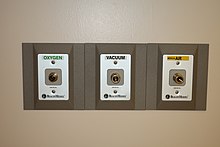
The Atlas Copco Group has dozens of brands around the world, including Chicago Pneumatic for compressors and tools, Edwards for vacuums, BeaconMedeas for medical gas and SCA & Henrob for automotive assembly.[18]
Notable brands include:
Structure
[edit]Atlas Copco's operations are organized into four business areas and more than 20 divisions. The organization has both operating units and legal units. Each operating unit has a business board. The duty of a business board is to serve as an advisory and decision-making body on strategic operational issues. It also ensures the implementation of controls and assessments. Each legal company has a legal board focusing on compliance and the legal structure of the group.[19]
In 2018, Atlas Copco decided on a split and formed Epiroc AB which will focus on customers in the mining, infrastructure and natural resources segments. Epiroc is a fully independent company.[20]
Innovation
[edit]Atlas Copco conducts research and development in a wide range of technologies at their global research centres, where each division has its own individual area of focus and resources. Training and workshops have been rolled out in customer centres and product companies globally. The company puts its focus on growth in automation to bring more production back to the US and Europe. In 2020, Atlas Copco acquired Isra Vision in February[21] and Perceptron in September[22] to automate more.[23] In March 2022, Atlas Copco acquired the assets of Ceres Technologies,[24] an US-based manufacturer and designer of gas and vapour delivery equipment for the semiconductor industry.[25]
References
[edit]- ^ Nasdaq Nordic
- ^ Nasdaq Nordic shares
- ^ a b c d e "Atlas Copco Group 2020 Annual Report" (PDF). Atlas Copco. 31 December 2020. Retrieved 27 August 2021.
- ^ "Koncernstruktur ATLAS COPCO AB". Solid Info. Retrieved 4 April 2015.
- ^ "Annual Report 2014". Atlas Copco. Archived from the original on 10 April 2015. Retrieved 4 April 2015.
- ^ "Facts in brief". Atlas Copco. Archived from the original on 4 April 2015. Retrieved 4 April 2015.
- ^ Burton, John (2006). "Atlas Copco AB". International Directory of Company Histories. Gale Group. Retrieved 29 September 2010.
- ^ Kinnander, Ole (22 September 2010). "Atlas Copco Says Mining Demand Quickened in Third Quarter on Metal Prices". Bloomberg. Archived from the original on 28 September 2010. Retrieved 29 September 2010.
- ^ "Atlas Copco Facts in brief". Atlas Copco.
- ^ "From Atlas to Atlas Diesel". Atlas Copco. Archived from the original on 16 April 2016. Retrieved 4 April 2016.
- ^ a b "International acquisitions and expansion - Atlas Copco History between 1873 and 2013". Archived from the original on 23 June 2016. Retrieved 16 June 2016.
- ^ "Milwaukee Electric Tool, other units to be sold for $626.6M". 30 August 2004. Archived from the original on 19 April 2005.
- ^ "Organization". Atlas Copco.
- ^ "Compressor Technology". Atlas Copco.
- ^ Atlas Copco for investors [permanent dead link]
- ^ Copco, Atlas. "Construction Technology - Atlas Copco". Archived from the original on 31 May 2016.
- ^ a b "Atlas Copco Annual Report 2019" (PDF). Atlas Copco Group.
- ^ "Brands". Atlas Copco. Archived from the original on 30 September 2020. Retrieved 18 September 2020.
- ^ "This is how we do business". Atlas Copco Group.
- ^ Epiroc cements Atlas Copco split with Nasdaq listing. Archived 24 July 2019 at the Wayback Machine Australian Mining.
- ^ "Leading Machine Vision Systems". Isra Vision.
- ^ "History".
- ^ "Atlas Copco chief sees growth in automation as onshoring intensifies". ft.com. Financial Times. 2020. Archived from the original on 10 December 2022.
- ^ "Home". Ceres Technologies. Retrieved 16 February 2023.
- ^ "Evertiq - Atlas Copco to acquire US supplier to the semiconductor i..." evertiq.com. Retrieved 17 March 2022.
External links
[edit] Media related to Atlas Copco at Wikimedia Commons
Media related to Atlas Copco at Wikimedia Commons
- Companies related to the Wallenberg family
- Tool manufacturing companies of Sweden
- Manufacturing companies established in 1873
- Swedish brands
- Companies listed on Nasdaq Stockholm
- Companies in the OMX Stockholm 30
- Companies in the OMX Nordic 40
- Companies based in Stockholm County
- Multinational companies headquartered in Sweden
- Swedish companies established in 1873
- Nacka Municipality

